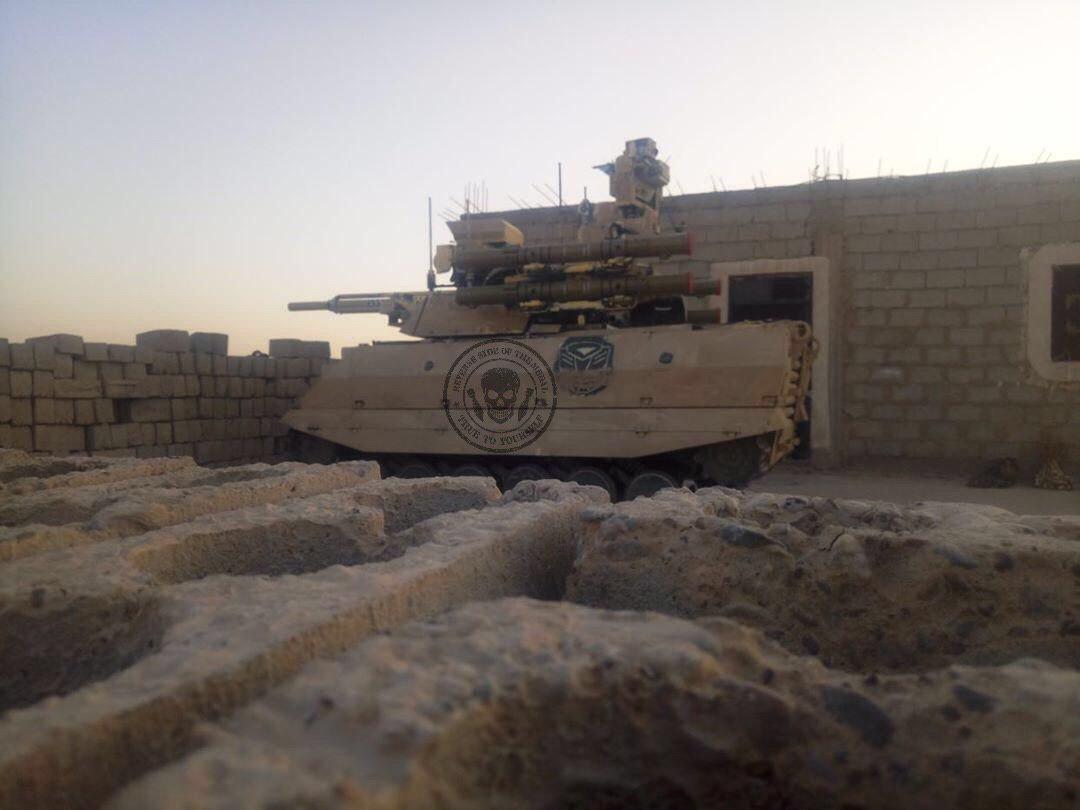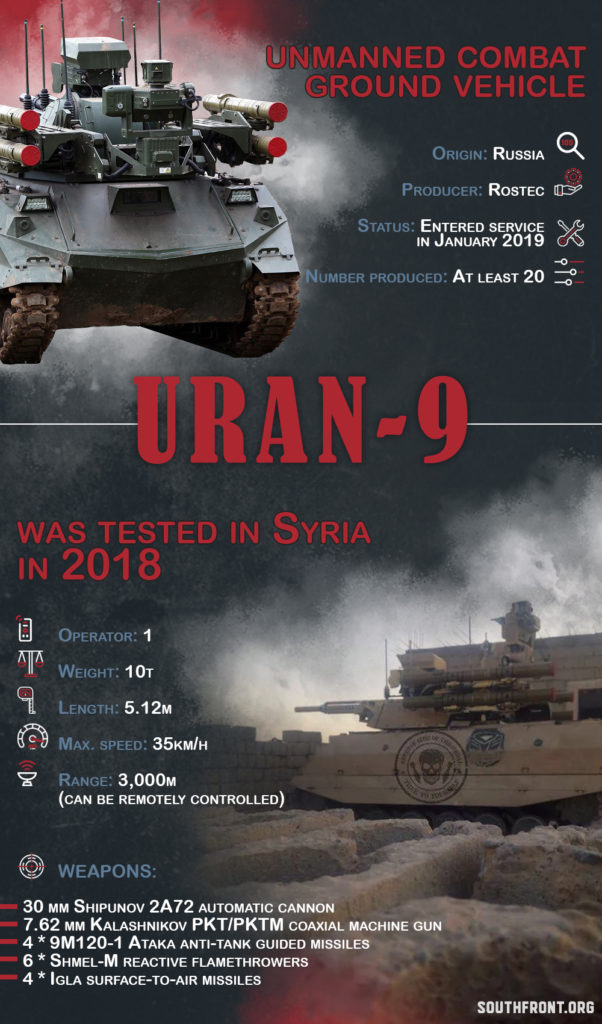
The Uran-9 with a logo of the “Autobots” from Transformers on its chassis is in Syria. Click to see full-size image
In recent days, images and videos of the Russian Uran-9 unmanned ground combat vehicle have surfaced online. These images became a visual confirmation that the Uran-9 was in fact tested in combat conditions in Syria. The combat robot deployment in the war-torn country took place in 2018. According to experts, it’s unlikely that Uran-9s are now involved in any operations across Syria.
The Uran-9 multipurpose unmanned ground combat vehicle was unveiled by Russian military equipment manufacturer JSC 766 UPTK during the Army-2016 International Miltary-Technical Forum held in Russia in September 2016.
Prior to its reveal, in 2015, Rostec Corporation’s Rosoboronexport said that it would promote the Uran-9 combat robot to international markets, starting from 2016.
The vehicle is designed to provide remote reconnaissance and fire support to a variety of tasks conducted by the counter-terrorism, reconnaissance and military units in urban environments.
The Uran-9 can be used full autonomously on a predefined road or manually operated by one man from a truck control station or via a small backpack control station.
Back in 2016, the Uran-9 was armed with a 30mm Shipunov 2A72 automatic cannon, four ready-to-launch 9M120-1 Ataka (NATO reporting name: Spiral-2) anti-tank guided missiles (ATGM), six ready-to-launch Shmel-M reactive flamethrowers. and a 7.62mm Kalashnikov PKT/PKTM coaxial machine gun mounted to the left side of the main armament. The Uran-9 can be also armed with four Igla surface-to-air missiles.
There are two Ataka missile launchers and three Shmel-M on each side of the turret. The Ataka missile has an operational range from 400 m to 6 km, and is capable of penetrating armour to a depth of 800mm behind explosive reactive armour (ERA).
The Uran-9 unmanned ground combat vehicle has the ability to resist firing of small arms ammunition and shell splinters. The steel armour plates of the hull offer protection for the vehicle suspension.
The robotic system is equipped with various remote-controlled sensor modules such as laser warning system, and electro-optic and thermal imaging cameras. It has an onboard fire control system, comprised of automatic target detection, identification and tracking devices, as well as a ballistic computer. The systems are able of detecting and tracking targets at up to 6 km during the day and 3 km during the night.
The Uran-9 has two operation modes – autonomous and manual.
- In autonomous it can automatically identify, detect, track and defend enemy targets based on the pre-programmed path set by the operator.
- The Uran-9 robot is manually controlled by a single operator from a mobile command and control station mounted on a 6×6 tactical truck from a safe distance of 3km.
The Uran-9 is powered by a diesel-electric power source, which provides a maximum speed of 35 km/h on a highway, and a max speed of 25 km/h cross-country. In off-road conditions it moves slow, at only 10 km/h. The robot’s tracked chassis offers increased cross-country mobility. The average specific ground pressure is 0.6kg/sq.
The Uran-9 was commissioned in the Russian Armed Forces in January 2019, whereas it was tested in Syria in 2018. It furthermore was used during the Vostok-2018 military exercise.
In June 2018, RIA Novosti reported that some shortcomings in the combat capability of the Uran-9 were established, while it was being used in Syria.
Military experts discovered flaws in the control, mobility, firepower, intelligence and surveillance functions of the robot. In addition, with the independent movement of Uran-9, a low reliability of the running gear – track rollers and guide rollers, as well as suspension springs were discovered.
The robot also showed the unstable operation of a 30-mm automatic gun, untimely triggering of the start circuits, and the failure of the thermal imaging channel of the optical sighting station.
In April 2019, Interfax cited the Deputy Chief of the General Staff of the RF Armed Forces, Chairman of the Military Scientific Committee of the Armed Forces, Lieutenant General Igor Makushev who said that the deficiencies in the robot were all removed by the development team.
In 2019, there were more issues with the Uran-9, it allegedly had problems with losing connection to the command post. Unlike flying drones, the control signal of a radio-controlled machine can be lost when passing through mountains, buildings and other objects. During tests in Syria, this led to a loss of the signal approximately 17 times for 1 minute, and twice the connection with the combat robot was lost for an hour and a half.
Reportedly, problems with rollers and suspension springs may occur in the Uran-9’s undercarriage, which is why the robot needs frequent repairs and cannot be used for a long time. But the biggest problem remains that the remote-control system reportedly works at a distance of no more than 300-400 meters instead of the promised 3 kilometers.
Upwards of 20 units of the Uran-9 have been constructed as of December 2019, and the deployment in Syria was generally regarded as positive and successful. Even if the reports of the issues were true, they could be rectified in short-term development.
There is nothing new in the development and deployment of unmanned systems. Nonetheless, the approach demonstrated by the Russian Armed Forces is interesting because the Russian side works on the development and deployment of not separate robotic systems, but rather groups of robotic systems controlled by a unified control system within a single intelligent network. The composition of these groups can be adapted depending on tasks that they had to achieve on the battlefield. Furthermore, significant efforts were and some successes was already achieved in the task of allowing these robotic systems to operate autonomously within the group to fulfill the assigned task. This is the first step on a long road of creating a swarm of fully autonomous robotic systems that can perform assigned tasks without a direct involvement of operators. The Kungas robotic complex and the Okhotnik heavy unmanned aerial vehicle are the most vocal examples of this approach.
Another point is the functionalism of the Russian projects. Instead of pushing ahead military robot dogs or tiny combat drones (all these directions have apparent issues taking into account the current technological progress), the Russian military chose straightforward and effective decisions employing relatively large tracked platforms that do not require non-existing engineering solutions. This allowed Moscow to focus on what really matters: the employment of robotic systems in combat conditions and the development of their fully autonomous solutions.
MORE ON THE TOPIC:








Wow I’d trip out if I seen one of them seems too me it’d be good for keeping an eye out for half track, troop movement, and supply line’s and concentrate on water supply if it has the range of 3 to 6 km but I cannot see an advantageous implementation if it has only a short range it wouldn’t be beneficial with the lesser range
That’ll do sum Damage…don’t forget to install Elite-Facial-Recognition